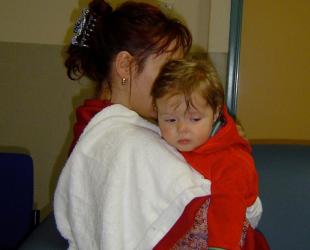Too much milk, green poos and an unsettled baby? Here's what to know about lactose overload.

Lactose overload happens when breastmilk moves through your baby’s system too quickly for all the lactose to be digested. This can make your baby unsettled and affect their nappies.
Symptoms of lactose overload
Lactose overload can cause:
- wind and tummy pain
- lots of wet nappies
- frequent large, runny poos which might be green, frothy or explosive*
- nappy rash (because the poo is more acidic)
- your baby being very unsettled
- good or even large weight gains
*Green poo on its own can be normal. If it’s dark green but in small amounts, it might mean your baby isn’t getting enough milk.
Why does lactose overload happen?
Lactose is a natural sugar found in breastmilk, and it’s there in about the same amount from the start to the end of a feed. Fat, on the other hand, increases as your breast empties. In the past, people talked about “foremilk” (milk with less fat) and “hindmilk” (milk with more fat), but now we know the change in fat is gradual, not sudden.
Fat in breastmilk is important because it helps slow down how quickly milk moves through your baby’s gut. This gives your baby’s body more time to break down the lactose. If milk moves too fast—often because there’s a lot of milk or because feeds are short—your baby might not get enough of the fat-rich milk. That means the lactose doesn’t get fully digested, which can lead to wind and tummy pain.
If you have a lot of milk, your baby might fill up before getting enough of the fattier milk. Switching sides too soon can have the same effect. Your baby might then have tummy pain and want to suck more often for comfort. Sometimes, giving more feeds or swapping sides a lot can make things worse, and it might even seem like your baby is always hungry—leading some mums to worry about low milk supply, when it’s actually about how the milk is being taken in.
What to do if you think you have lactose overload
Step 1: Focus on reducing oversupply first
If you think your baby’s symptoms are due to lactose overload, the first thing to do is take steps to reduce your milk oversupply. Most of the time, making changes to how you feed—like offering one breast per feed or spacing out feeds—can help settle things down.
Step 2: Try block feeding
If you’ve tried reducing your oversupply and things haven’t improved after a few weeks, you could try block feeding.
Block feeding is a short-term method to help slow down your milk production and give your baby the balance of fat-rich milk and lactose they need.
How does block feeding work?
- For a set period (usually 4 hours), feed your baby from just one breast each time they want to feed.
- They can feed from the same breast many times in the block of time.
- After that time is up, switch to the other breast for the next block of time (another 4 hours).
- Each time your baby feeds from the same breast, they get milk that’s higher in fat, which helps slow things down in their tummy and can ease symptoms.
If your other breast feels too full or uncomfortable, you can make the blocks shorter (for example, 3 hours instead of 4).
Important things to know:
- Only use block feeding if you’re sure you have too much milk and your baby is gaining weight well.
- You should see a difference in your baby’s symptoms in 1 to 3 days.
- Stop block feeding as soon as your baby’s symptoms improve—don’t keep going longer than needed, as it’s designed to reduce your milk supply.
- An ABA breastfeeding counsellor or lactation consultant can help guide you through this process.
© Australian Breastfeeding Association November 2025
Read more about oversupply
Online interactive session free for members
Newborn Virtual Village: working out your supply

Evidence-led info and practical tips from our Breastfeeding Information Series
Breastfeeding: and your supply






